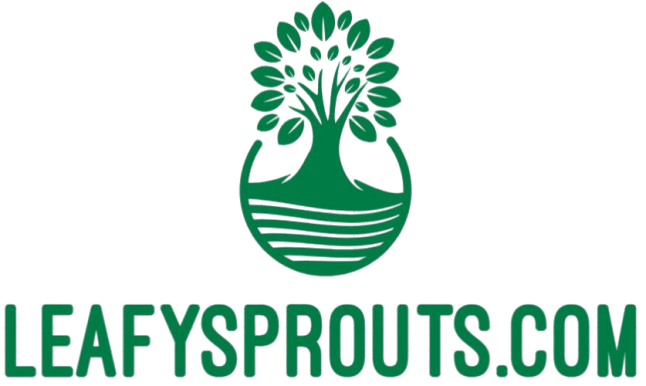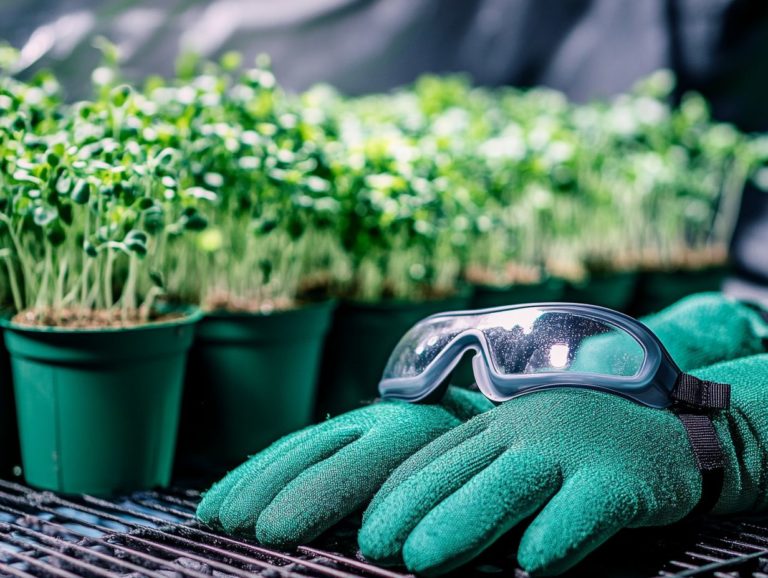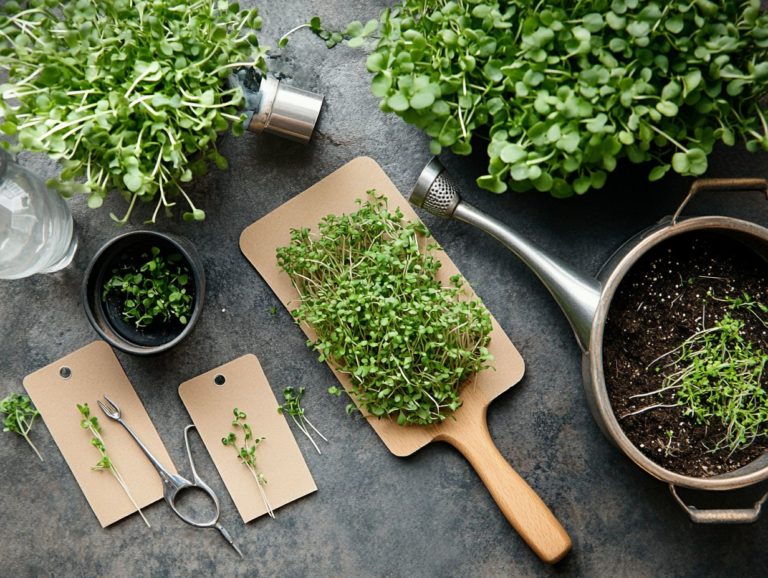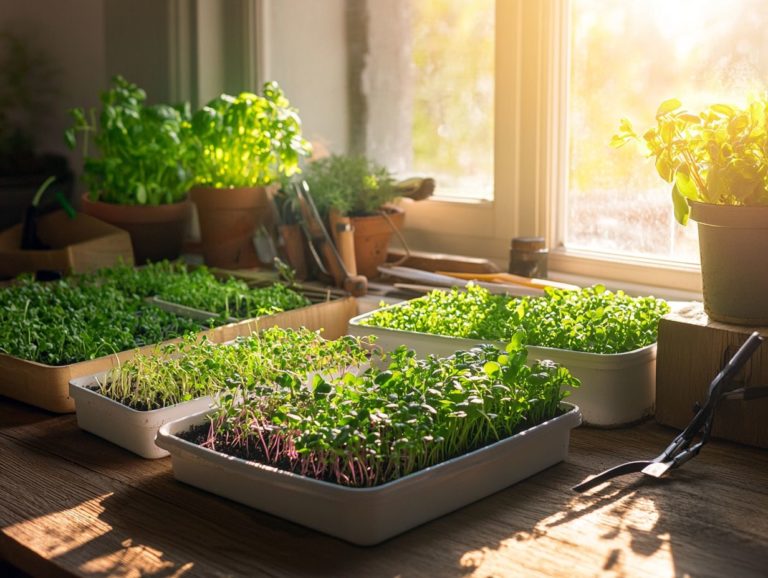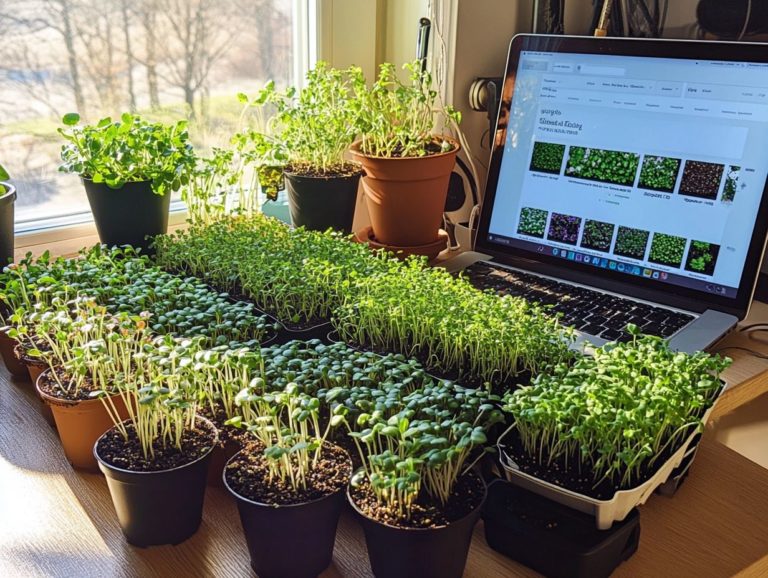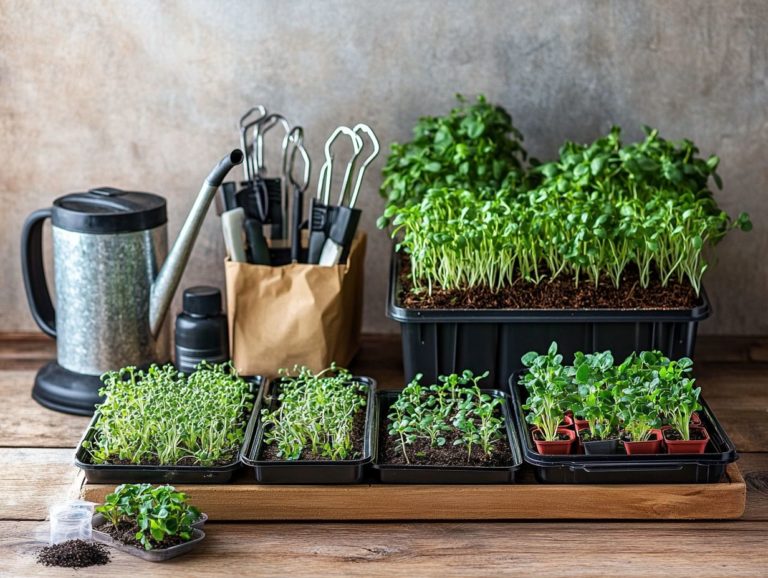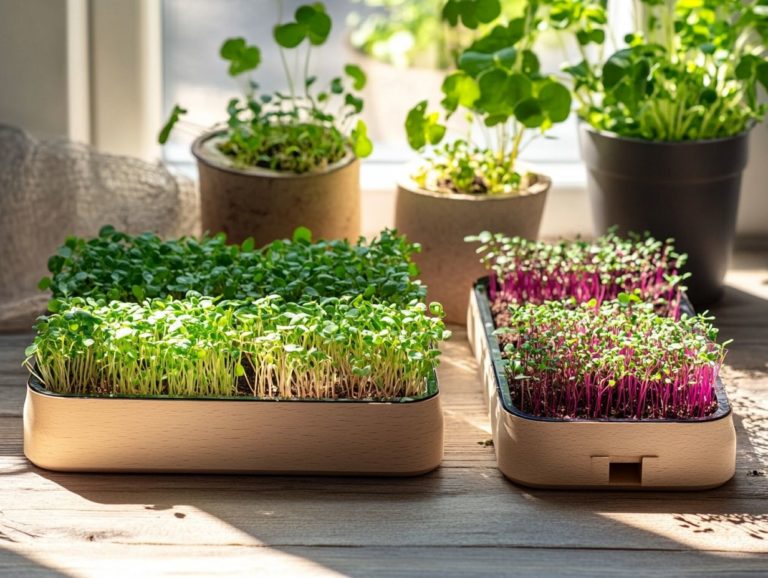How to Maintain Humidity for Microgreens
Humidity plays a pivotal role in the successful growth of microgreens, impacting everything from germination to flavor.
As you cultivate these vibrant greens, grasping the optimal humidity levels for various growth stages becomes essential. This guide will empower you to master humidity control for lush, thriving microgreens!
Dive in now to discover the secrets of humidity control while tackling common challenges and sharing best practices that ensure your microgreens not only survive but thrive.
Contents
- Key Takeaways:
- Understanding Humidity for Microgreens
- Optimal Humidity Levels for Microgreens
- Methods for Maintaining Humidity
- Challenges and Solutions
- Additional Tips for Humidity Control
- Frequently Asked Questions
- What’s the best humidity level for growing microgreens?
- Why is humidity important for microgreens?
- How can I measure the humidity level for my microgreens?
- What are ways to increase humidity for my microgreens, such as red beet microgreens and broccoli microgreens?
- Are there risks associated with high humidity for microgreens, such as mold and pests?
- Can I use a humidifier to maintain humidity for plants like Italian basil and red cabbage?
Key Takeaways:
- Maintaining proper humidity is crucial for healthy microgreens as it affects their growth, moisture levels, and disease resistance.
- The ideal humidity range for microgreens varies depending on the growth stage, with higher levels for germination and lower levels for later stages.
- To maintain optimal humidity, use trays, covers, and misters. Be aware of common challenges and address them promptly to ensure the health of your microgreens.
Understanding Humidity for Microgreens
Understanding humidity is essential for your successful microgreen cultivation. It profoundly influences when seeds start to grow, growth factors, and overall crop production.
Microgreens such as fenugreek, red beet, broccoli, red cabbage, white mustard, and Italian basil thrive under specific humidity levels. It’s vital for you to create an indoor farming environment that replicates these optimal conditions.
Excessive humidity can invite mold, while insufficient humidity can stifle growth.
What is Humidity and Why is it Important for Microgreens?
Humidity is all about the moisture in the air, and it plays a pivotal role in the growth and health of your microgreens. Understanding the intricacies of humidity levels is crucial for creating the ideal growing conditions. Fluctuations can lead to health risks, like mold development.
Your microgreens thrive best at specific humidity levels, particularly during germination when higher moisture can speed up seed sprouting. To ensure your microgreens are healthy, consider using watering techniques for thriving microgreens. On the flip side, too much humidity during the growth phase can invite fungal diseases, while low humidity might stunt growth and compromise crop quality.
Striking that delicate balance promotes vigorous growth and minimizes health risks, such as the spread of pathogens that threaten both the plants and you as a grower. Therefore, mastering humidity management is essential for ensuring a bountiful microgreens harvest and maintaining a healthy environment for your plants. Additionally, learning how to use grow lights for microgreens can further enhance your growing success.
Optimal Humidity Levels for Microgreens
Achieving optimal humidity levels is crucial for your microgreens. It greatly impacts key growth factors like germination, crop cycles, and overall health.
Different varieties, such as fenugreek and Italian basil, flourish under particular humidity conditions. It is essential for you to maintain precise control to maximize your crop production.
Ideal Range for Different Stages of Growth
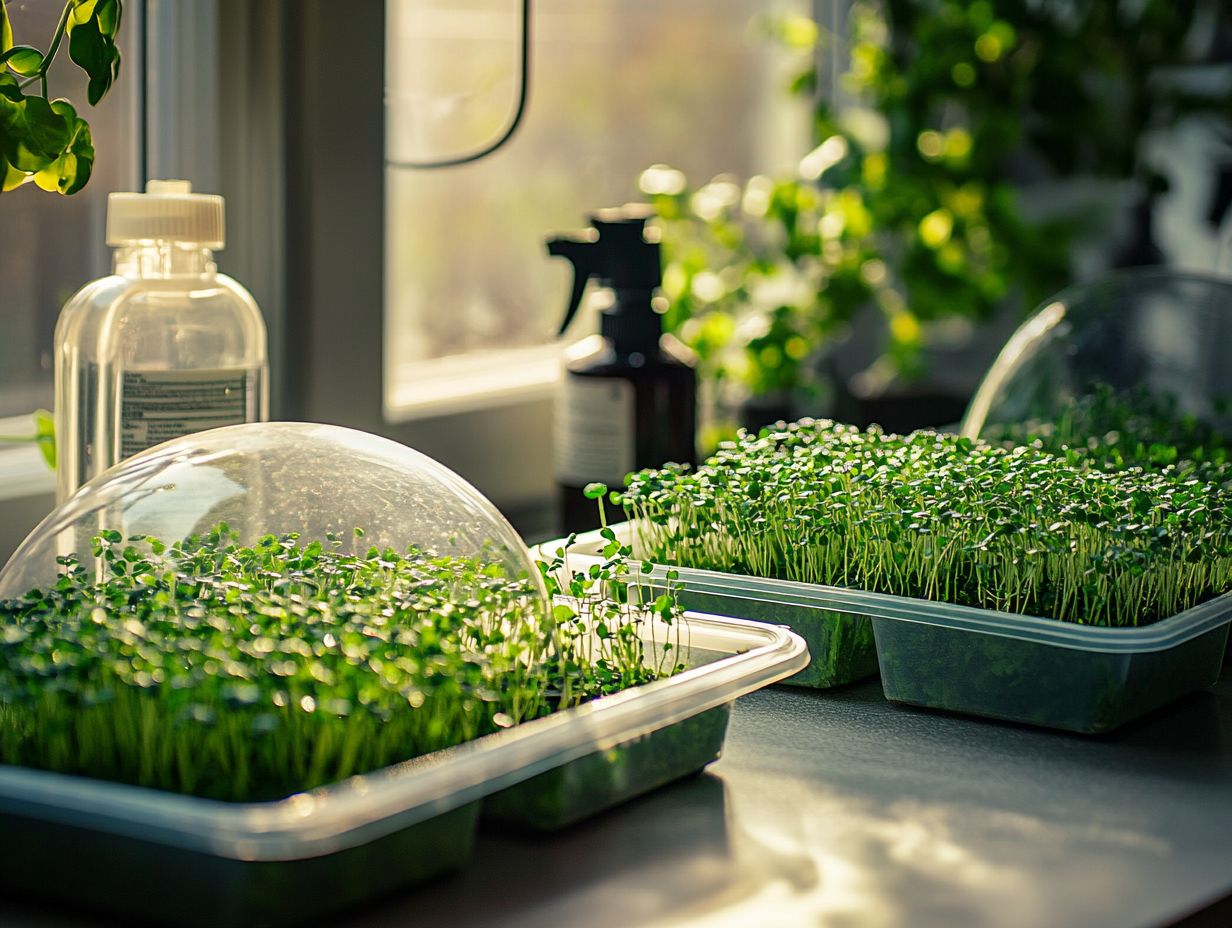
The ideal humidity range for your microgreens will vary based on their specific growth stages. This significantly influences germination and the development of healthy plants. For instance, seeds like fenugreek and broccoli thrive best in higher humidity during the germination phase, ensuring robust growth.
To promote swift sprouting and minimize the risk of seed rot, aim for humidity levels around 70-80% during this crucial phase. As your microgreens transition to the seedling stage, gradually reducing humidity to 50-70% will help strengthen their stems and leaves. For more tips, check out this guide on how to maximize yields from microgreens.
Once they reach maturity, a drier environment around 40-60% will be optimal, fostering resilience and intensifying flavor. To create these conditions, consider investing in a cover that helps keep moisture in at the outset. As they grow, employing fans and ventilation will effectively regulate air circulation.
Monitoring humidity with a hygrometer is essential to ensure that any fluctuations don t compromise the quality of your microgreens.
Methods for Maintaining Humidity
Maintaining humidity in your indoor garden is essential for the health of your microgreens. You have several effective methods at your disposal.
Utilize trays, covers, and misters to create the right environment. Ensure proper air circulation and incorporate dehumidifiers devices that reduce moisture in the air for optimal moisture levels.
Using Trays, Covers, and Misters
Using trays, covers, and misters is a stellar strategy for nurturing your microgreens. This approach allows you to maintain optimal moisture control during the germination phase and beyond.
These tools set the stage for your microgreens to thrive while minimizing the risk of mold.
Trays serve as a reliable foundation, retaining excess water and ensuring even moisture distribution across your growing medium. By choosing trays with proper drainage, you can effectively prevent waterlogging, which is essential for promoting healthy roots.
Covers are your secret weapon for enhancing humidity. They trap moisture, creating a mini-greenhouse effect that encourages seed sprouting without overwhelming those delicate plants. To optimize airflow for microgreens, consider using covers with adjustable vents or briefly removing them to let in fresh air.
Misters are crucial for fine-tuning humidity levels. A gentle misting can refresh moisture levels without drowning the soil. For the best results, mist in the early morning to give your microgreens ample time to absorb moisture before they bask in the light.
Challenges and Solutions
Humidity challenges in indoor farming can pose serious threats, leading to issues like mold growth and pest infestations that can wreak havoc on your microgreens.
Recognizing these challenges and implementing effective solutions is essential for cultivating a thriving and healthy growing environment.
Common Issues and How to Address Them
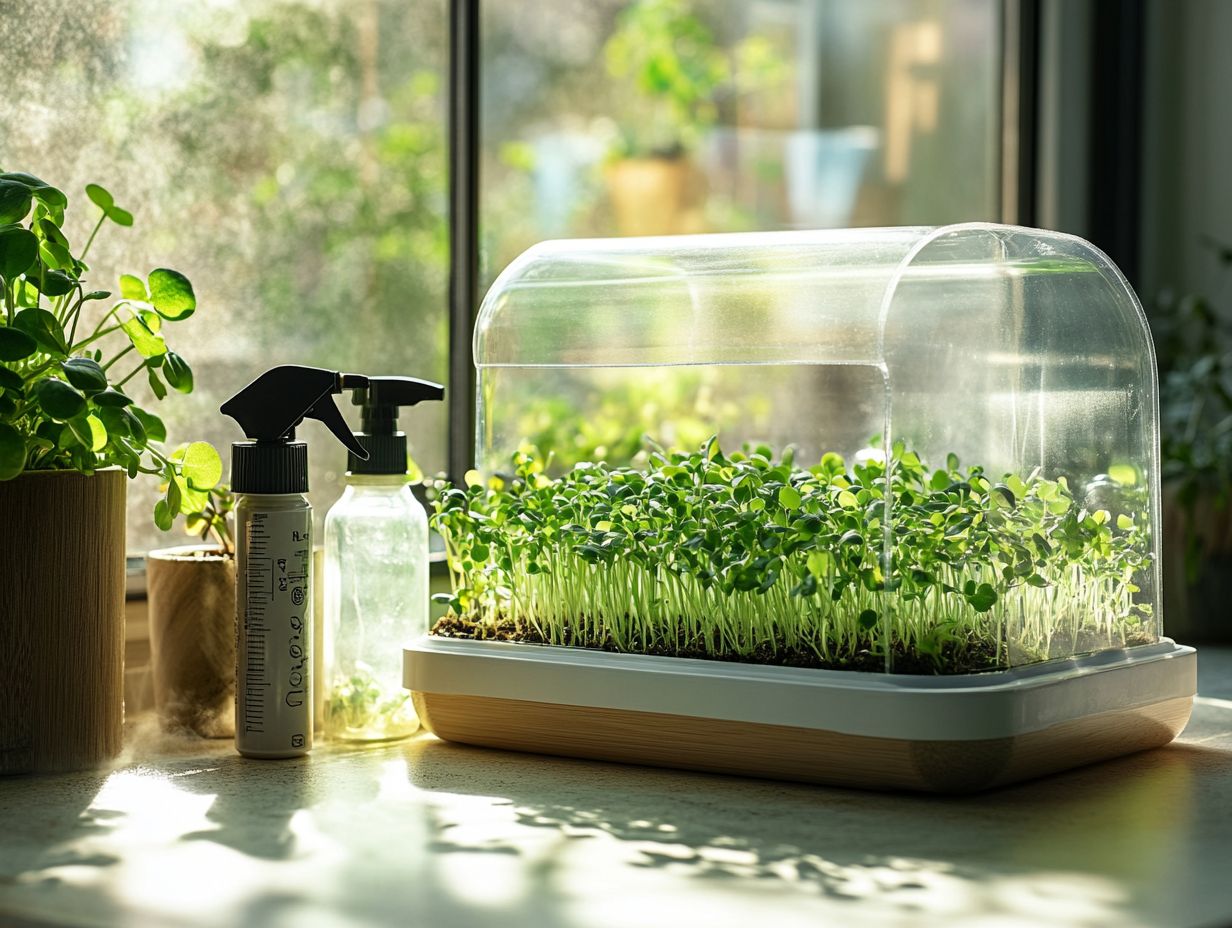
Common issues related to humidity can include pesky mold development and pest control challenges threatening the health of your microgreens. Tackling these problems requires a proactive approach to moisture monitoring and air circulation management.
If you fail to manage humidity effectively, you risk letting mold proliferate. This not only disrupts the growth of your microgreens but also poses health risks for consumers. High humidity invites pests that can quickly ruin your precious crops! To prevent these issues, consider learning How to Use Hydroponics for Microgreens! Act fast!
To counter these challenges, utilize air extractors to significantly boost air circulation, reduce moisture levels, and deter mold growth. Incorporating humidity monitoring tools will help you keep a vigilant eye on moisture levels and make necessary adjustments in real-time.
Together, these solutions provide a comprehensive strategy for maintaining a thriving growing environment and preventing infestations.
Additional Tips for Humidity Control
By implementing additional tips for humidity control, you can significantly elevate the health of your microgreens, ensuring sustainable growth and optimal conditions.
Embrace best practices like regular monitoring and effective air circulation to contribute to a flourishing indoor garden environment.
Take action now and share your experiences with maintaining humidity in your indoor garden!
Best Practices for Growing Healthy Microgreens
Following best practices is essential for growing healthy microgreens. Keeping the right moisture and humidity is key to creating optimal growth conditions that ensure robust and resilient crops.
To achieve this, regularly monitor the humidity levels in your growing environment. A humidity dome is an excellent tool that helps maintain moisture and creates a microclimate that promotes rapid germination.
Using a spray mister or fine misting system can provide consistent moisture, which is critical for seedling health. A digital hygrometer helps you track humidity easily, ensuring your microgreens thrive!
Employing trays with drainage holes is another crucial step in moisture management. This prevents overwatering and root rot, leading to flourishing microgreens that are ready for harvest.
Frequently Asked Questions
What’s the best humidity level for growing microgreens?
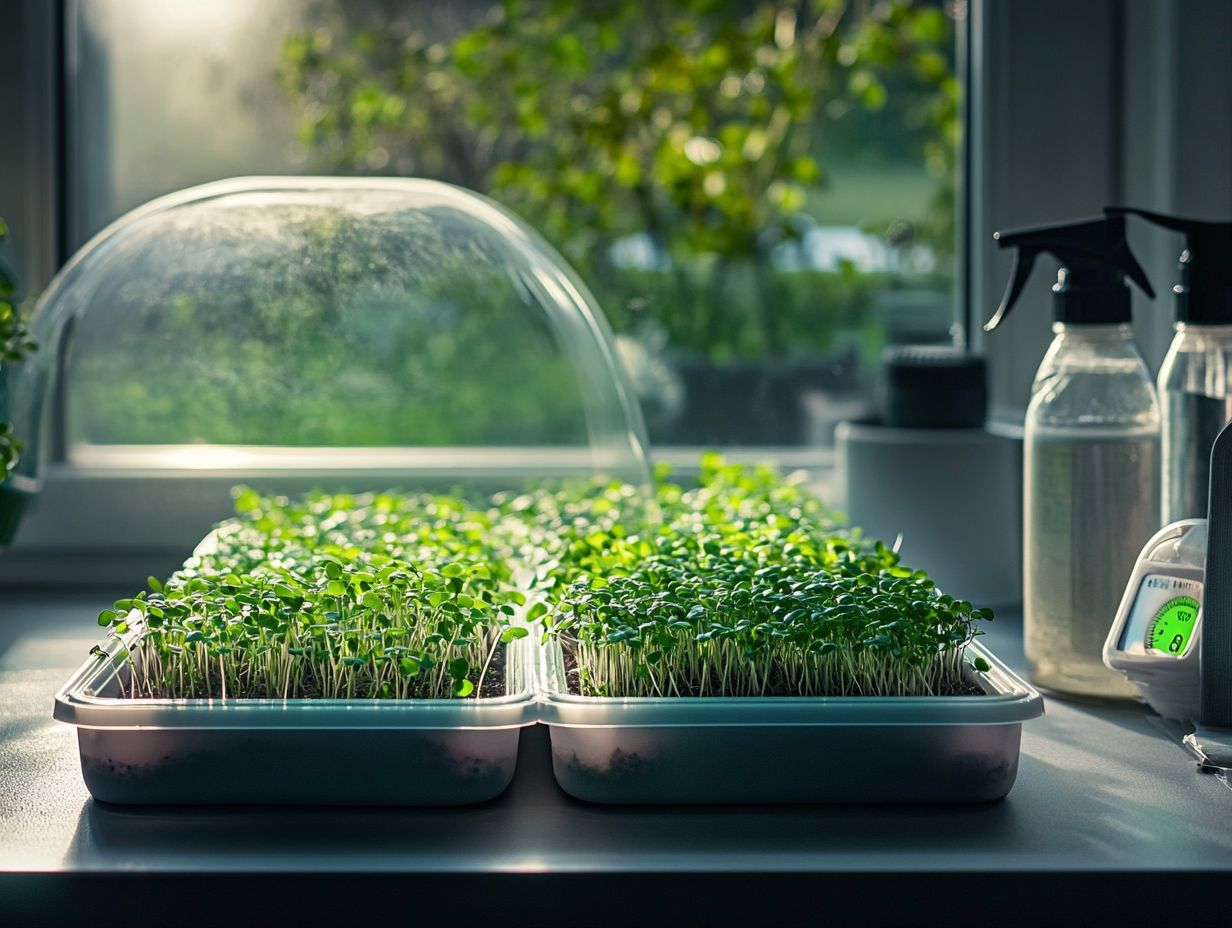
The ideal humidity level for growing microgreens is between 60% and 70%. This range mimics their natural environment, helping them thrive.
Why is humidity important for microgreens?
Microgreens are delicate plants that need a specific level of humidity to grow successfully. Maintaining humidity prevents the plants from drying out and encourages germination and growth.
How can I measure the humidity level for my microgreens?
You can measure the humidity level for your microgreens using a hygrometer, which is a handy tool that measures humidity. This can be easily purchased at most gardening or hardware stores.
What are ways to increase humidity for my microgreens, such as red beet microgreens and broccoli microgreens?
One way to increase humidity is to place a tray of water near the plants. As the water evaporates, it creates a more humid environment. You can also mist the plants and their surrounding area with a spray bottle.
Are there risks associated with high humidity for microgreens, such as mold and pests?
Yes, high humidity levels can lead to mold and fungal growth on your microgreens. It s important to monitor humidity levels and adjust them as needed to prevent any issues.
Can I use a humidifier to maintain humidity for plants like Italian basil and red cabbage?
Yes, a humidifier can be used to maintain humidity for your microgreens. Just make sure to monitor humidity levels to avoid over-saturating the plants, as this can also lead to mold and fungal growth.
